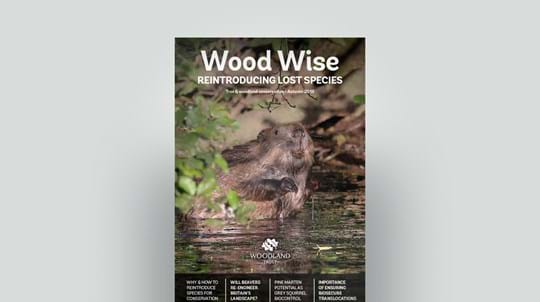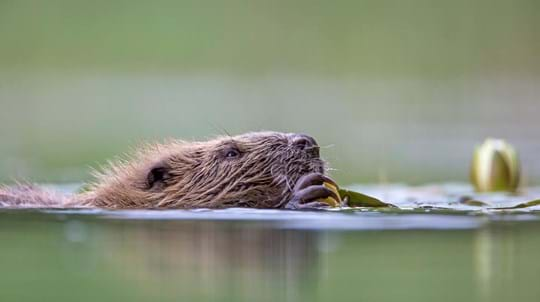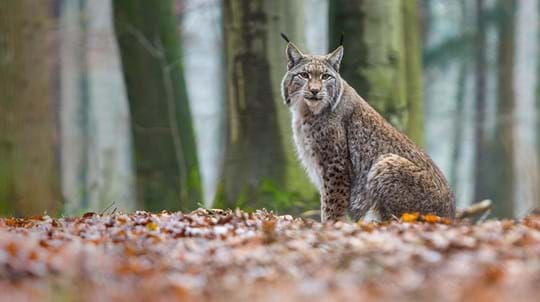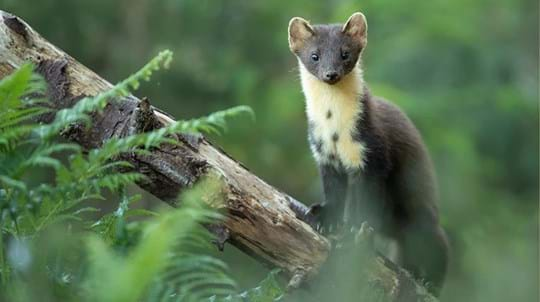
Pine marten reintroduction: how we're helping and where to find them
Pine martens were once one of our most common carnivores. These days their numbers are pitifully low. But thanks to expertise, passion and partnership working, they're back from the brink. Find out how we're helping pine martens make a welcome return to the UK's woods.
They’re fiercely shy, but pine martens are peeping once again in the woods of southern Britain.
Matthew Davies, a volunteer with Vincent Wildlife Trust's (VWT) Pine Marten Recovery Project has been monitoring the spread of these woodland wraiths since they returned to Wales in 2015. It is proving a challenge:
"A few times I’ve glimpsed what looks like a chocolate-brown cat legging it into the undergrowth, but they’re lightning fast. It’s blink-and-you-miss-it."
Elusive they may be, but sightings of Britain’s largest tree-dwelling mammal are now becoming more common. As well as the growing marten population in Mid Wales, 18 Scottish pine martens arrived in the Forest of Dean in 2019, while a further 15 of these rare animals were translocated to Devon in autumn 2024 – the latest release in a bid to reintroduce a creature that was driven to the edge of extinction south of the border.
"I've been hunting for martens for years now, and the closest I've come to one in the flesh is a scarpering rear-end!" says Matthew Davies, Mid Wales' top pine marten tracker.
Wales
With our help, 51 martens have been released around Devil’s Bridge, near Aberystwyth.
Before the Pine Marten Recovery Project began, the last recording of a Welsh pine marten was as roadkill near Newtown in 2012.
"The old boys in the pub recall seeing pine martens up here in the 1970s – it’s the perfect habitat for them," says Matthew. "They tell stories of farmers hunting ‘brown raccoons’".
Between 2015 and 2018, VWT translocated 51 adult pine martens from Scotland, where they are doing well, to Mid Wales, where they were heading for extinction. It was the first carnivore recovery programme of its size in Britain. This translocation was the culmination of many years' research, a detailed feasibility study, extensive community engagement and the hard work of dedicated scientists, conservationists and local volunteers.
The Welsh martens were radio-tracked for their first year, allowing VWT to record their patterns of movement and territorial behaviour. Once the radio collars were removed, tracking continued using remote cameras and regular scat hunts – helped by an army of enthusiastic local volunteers. Breeding has taken place every year since 2015 and, with the help of volunteers and remote cameras, VWT continues to monitor the martens' spread as they set up new territories away from the Mid Wales release area. Matthew regularly journeys high into our woods at Cwm Mynach, in the Rhinog Mountains, on their tail.
Matthew’s got his work cut out. He tackles the final ascent on foot, clambering steeply among primeval oaks to retrieve data from his two cameras. The aim is to gain insights into the health and habits of the burgeoning population, and so far he has captured footage of several different martens, told apart by their unique cream bib patterns. He now has three males, two females and three kits on his books.
On one occasion, Matthew recorded a marten leaping from a tree to catch a vole.
"It was magical, and payback for all the hard work. If I find droppings in an area, I'll leave eggs or other bait a few feet up a tree, beyond the reach of foxes and badgers. I wait for repeat raids, then rig up my camera and cross my fingers."
Matthew returns his footage to Vincent Wildlife Trust HQ, where the team logs all the evidence of the Welsh martens' distribution. Project manager, Dr Jenny MacPherson, confirms the team is cautiously optimistic that we now have a self-sustaining pine marten population in Mid Wales. A cause for much celebration.
England
Pine martens have returned to Devon!
Pine martens are back in Devon for the first time in more than a century. Seven males and eight females are now living wild in the woods of Dartmoor, where they were released in the autumn of 2024.
The return of these playful mustelids to our woodland ecosystem is thanks to the Two Moors Pine Marten Project, a partnership between seven conservation organisations, led by the Devon Wildlife Trust.
We’ve been involved in many ways:
- our volunteers helped to survey the woods and assess the suitability of the habitat before the pine marten release
- timber from restoration work at Fingle Woods was milled locally and used to create release pens. These provided safe locations where the pine martens could settle into their new environment upon arrival
- our staff members helped transport the pine martens from Scotland to their new home in Devon.
By the end of the project, pine martens will be reintroduced to both Dartmoor and Exmoor, marking a crucial milestone in the return of this precious species to Devon’s woodlands.
The reintroduction drive in England is led by Gloucestershire Wildlife Trust and Forestry England and backed by £65,000 from the Woodland Trust.
Meanwhile, pine martens continue to expand across the Forest of Dean.
Martens disappeared from the ancient hunting ground of the Forest of Dean 200 years ago.
"We spent five weeks on old-fashioned fieldwork in north-east Scotland," says Dave. "It was up at 5am and out all day in the forests, tracking, trapping and assessing animals’ suitability for translocation. You feel incredibly privileged to see these exquisite creatures up close in the wild, but the weight of responsibility for their welfare is stressful."
Meanwhile, project chiefs in Gloucestershire have been preparing locals and landowners for the arrival of these arboreal hunters.
"People want to know what impact they might have on other wildlife," says Dave, "and there are worries about livestock and commercial shoots.
"But martens are very risk averse: they steer clear of open fields that expose them to predators like foxes and raptors. And they’re fiercely territorial and live in low densities, so their numbers are self-limiting."
Following extensive ecological and social feasibility studies, 18 pine martens were translocated to the county in autumn 2019. As in Wales, they were tracked during their first year using radio collars and are now monitored using camera traps and scat surveys.
In spring 2020, the project team confirmed that some of the martens had given birth to kits. The new arrivals are now fully grown and carving out territories of their own.
Many of the martens have taken up residence in the Forest of Dean and look set to stay, while others have wandered into neighbouring counties. It's a promising sign for the expansion of the future population.
The Gloucestershire Wildlife Trust team will continue monitoring the population as it expands, training up local volunteers to help with surveying. Squirrel monitoring is an important element of this work, aiming to shed more light on the complex relationship pine martens appear to have with the invasive grey squirrel.
Battling the greys: could pine martens save Britain's red squirrels?
One likely loser in this pine marten influx is the non-native grey squirrel. Studies in Scotland and Ireland have shown that when pine martens move into an area, greys move out, allowing once-abundant red squirrels to retake old stomping ground. Why?
- It could be down to the evolutionary instincts of native reds: perhaps they are better equipped to escape the clutches of their old foes than the North American greys.
- Other theories suggest greys are more vulnerable than reds because they feed on the ground, or because they are heavier and can’t scramble to safety in the spindlier upper branches.
Cat McNicol from Gloucestershire Wildlife Trust has researched the meal plans of the new Welsh martens since they moved south.
"Quite swiftly grey squirrels were making up about 14% of the martens’ diet," Cat reports. "Meanwhile the greys’ home ranges expanded, maybe because there was less competition for land. Some hope those shifts in behaviour could leave the door open for reds to return."
Setting the stage for success
For now though, Cat McNicol's focus is firmly on the new Forest of Dean martens.
"There are more potential conflicts here than in the Welsh project: more people, more roads, and greater exposure to other protected species like horseshoe bats and pied flycatchers. The incomers have scattered far and wide, and they will all wear radio collars for the first year, so we can keep an eye on them."
Bat roosts can be protected with climb-proof sheeting, and Cat says: "We know the chance of a marten repeatedly predating a roost is extremely low, but we are taking no chances. We want to ensure this project is held up as the gold standard."
Pine martens in our woods
They're shy. They're secretive. So it's unlikely you'll actually see one in the wild. The closest you're likely to get to a pine marten is its scat (poo), which these animals use to mark their territories.
What to look out for
- Look for tell-tale signs on paths, rocks and tree stumps.
- Take a whiff! If it’s sweet with a hint of parma violets (yes, really), you’re onto a marten. If it’s foul smelling, it's more likely fox or cat.
- Pine martens are bottom wigglers, so their scats tent to be wiggly. Fox poo is usually more solid and straight.
- Get more tips on identification and behaviour on our pine marten page.
Report any pine marten encounters to the Vincent Wildlife Trust.
Scotland
Once widespread across Scotland, pine martens are now most prevalent in the northern half of the country where there are reckoned to be around 3,700 adults. Here's where to look for tell tale signs.
Northern Ireland
As one of Northern Ireland’s rarest mammals, pine martens have clung on in isolated colonies in these woods.
Wales
Wales’s new pine martens have made a run for the hills, from the Brecon Beacons to Snowdonia. They can cover up to 20km a day, so you’d be lucky to see one in the flesh. Here are some woods to keep eyes peeled in.
England
Hunted to extinction across England, martens have been sighted fleetingly in Cumbria and Northumberland. If the Forest of Dean project flourishes, it’s hoped our woods in the Wye Valley could soon become new strongholds.
How you can help
The work we do is powered by the people who support us. It means we can protect trees and woods and restore ancient habitats before they're lost forever.

Become a member
Become a member of the Woodland Trust today and help save our precious woods and trees for future generations.
Find out moreMore on rare wildlife and reintroductions

Journal
Wood Wise – reintroducing lost species
PDF (2.57 MB)

Blog
Reintroducing lost species
Karen Hornigold • 29 Jan 2019

Blog
The UK's extinct animals: can we bring them back?
Sally Bavin • 12 Aug 2020

Blog
9 of the UKs rarest animals
Hannah Vickers • 15 Apr 2019

Blog
12 rare wild flowers in the UK's woods
Charlotte Varela • 13 May 2025
Blog
11 rare birds in Britain's woodland
Charlotte Varela • 10 Apr 2019




















